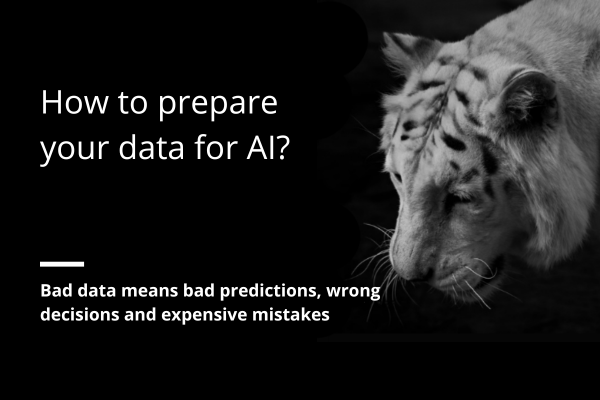AI is everywhere and it’s changing our businesses. But just like a high-performance sports car, the quality of fuel matters. It doesn’t matter how advanced your AI engine is: poor quality data will lead to poor performance. Bad data means bad predictions, wrong decisions and expensive mistakes. When your data is clean and well-prepared, however, your AI engine runs smoothly, delivering the insights and results your business needs to grow.
Let’s explore the five key steps that make your data AI-ready.
1. Ensure Data Quality
AI is like a sponge: it soaks up whatever data you give it. So, if your data is wrong, your AI’s output will be wrong too. Inaccurate data – whether it’s incorrect sales figures or outdated customer details – will lead to faulty predictions. Gartner reports that poor data quality costs companies the average of $15 million per year in losses.
- What to do: Use Data Quality tools and manual checks. Regularly validate and correct data as it flows through different systems.
2. Ensure data consistency
When each system uses a different definition, AI can get confused. For example, one system might list a customer under a nickname, while another uses their full name, leading to unreliable outcomes. McKinsey highlights data inconsistency as a major hurdle in AI projects.
- What to do: Use technology to enable real Data Governance and standardize information across departments. Create Single Entity View – a single source of truth for customer and operational data to ensure that AI has consistent, clean data to learn from.
3. Fill data gaps
If your AI is working with incomplete information, it’s like trying to finish a puzzle with missing pieces. These pieces of information – such as customer preferences or transaction histories – prevent AI from seeing the whole picture, which can lead to biased or incorrect outcomes.
- What to do: Regularly audit your datasets to ensure they are complete. Use data enrichment techniques, such as integrating external data sources or applying machine learning algorithms, to fill in the missing information.
4. Keep your data up to date
Outdated data leads to outdated predictions. Relying on last year’s customer data to predict future trends won’t work in fast-changing environments, which is why timely data is crucial. McKinsey report reminds us about all new regulations that have already made this obligatory for a huge part of data.
- What to do: Implement real-time data pipelines that continuously update your AI systems with the latest information. For datasets that don’t need real-time updates, schedule regular refreshes to ensure data is as current as possible. To lower infrastructure costs, consider virtual database.
5. Eliminate duplicates
In large organizations dealing with vast amounts of data, duplicate records are a common issue. Whether it’s multiple entries for the same customer or repeated sales transactions, duplicates can confuse AI models, leading to wrong insights and incorrect patterns. Typical examples would be incorrect customer LTV (Lifetime Value) calculation.
- What to do: Use automated Data Quality tools to deduplicate records and ensure your data is clean and unique.
Following these five steps ensures that your data isn’t just feeding AI. It’s empowering it to make reliable, business-changing decisions. But what happens in a different situation?
Few years ago IBM’s Watson for Oncology announced personalized cancer treatment, but it failed to deliver. The AI made treatment recommendations based on a very limited dataset that didn’t fully represent global healthcare practices. In one case, Watson suggested unsafe treatments because it wasn’t trained on diverse enough data.
Conclusion: good data = good AI
Getting your data ready for AI isn’t just a checkbox on your to-do list. It’s the foundation for your success. The truth is, AI systems are only as good as the data they learn from. By ensuring your data is accurate, consistent, complete, up to date and free of duplicates, you’re setting your AI projects up for success and avoiding the expensive mistakes.
Just like a master chef needs the best ingredients to create exceptional dishes, your AI needs top quality data to deliver remarkable insights and results. While technology keeps evolving, one principle remains unchanged: garbage in, garbage out. So invest in your data. And invest in your technology. To watch your AI not just performing, but growing your business in ways never possible before!









